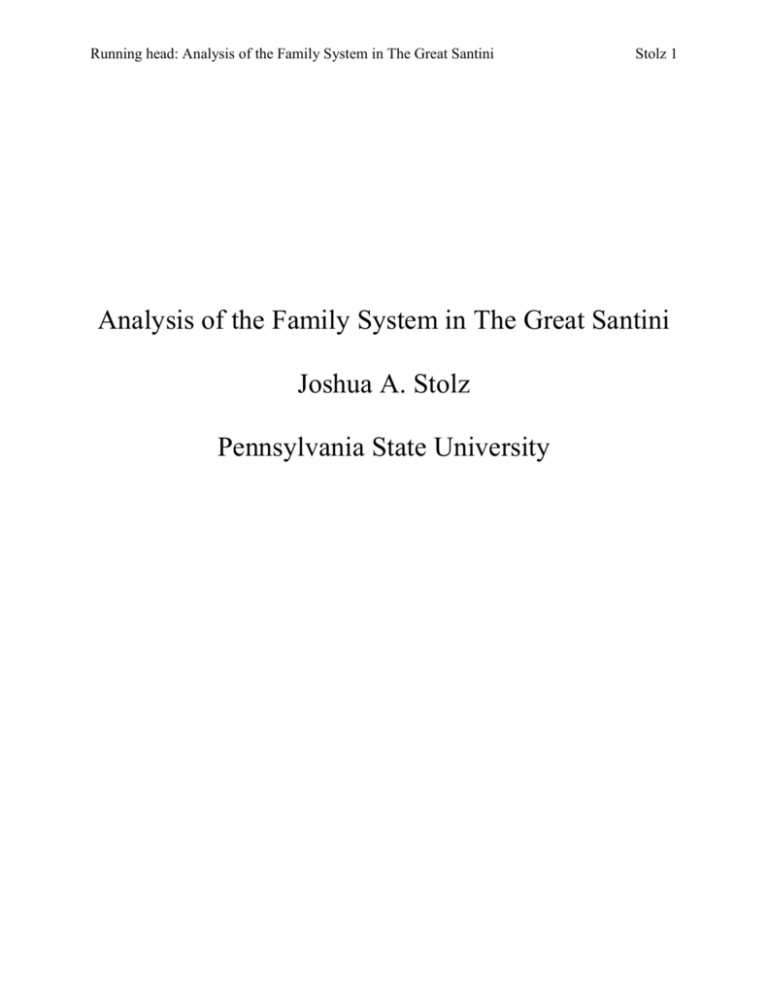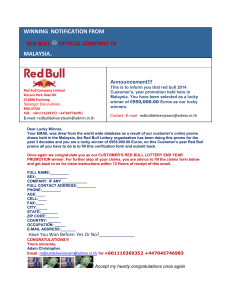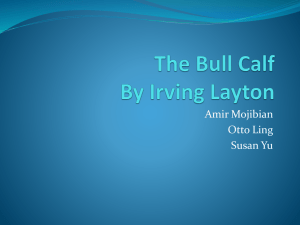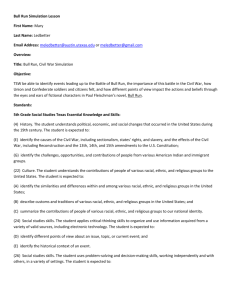Psych_490_Paper_Good - Sites at Penn State
advertisement

Running head: Analysis of the Family System in The Great Santini Stolz 1 Analysis of the Family System in The Great Santini Joshua A. Stolz Pennsylvania State University Running head: Analysis of the Family System in The Great Santini Stolz 2 Introduction The Meecham family is the focus of The Great Santini. The Meechams are a family system that has many strengths and weaknesses. There are both tendencies of healthy families and tendencies of dysfunctional families within the Meecham family. By analyzing each member of the family and looking at the Meechams through the Family Life Cycles approach, the Structural approach, the McMaster’s model, Cognitive theory, and Behavioral theory, the health of this family system will be determined. To better analyze the Meechams, a brief plot summary of The Great Santini will first be discussed. Plot Summary Patrick Conroy’s The Great Santini is a novel set in 1962 about the life of a military family, the Meechams. The Meecham’s nuclear family consists of the father Bull, mother Lillian, eldest son Ben, eldest daughter Mary Anne, and the two younger children Karen and Matt. The family has a background of frequently moving homes due to the unpredictable nature of the father’s position in the Marine Core. At the start of the novel, Bull returns home after a year of being stationed in Europe. During Bull’s absence, the family had been living in Atlanta with Lillian’s mother Alice. Upon Bull’s return the family must once again move to a military base in Ravenel, South Carolina. It is clear that the family has difficulties with this constant uprooting, especially the younger children who reminisce about formerly living in Cherry Point and Camp Lejeune. Bull is an authoritarian father who cares about his family, while at the same time, imposes rigid demands on them as well. Lillian and Bull have an affectionate relationship although this relationship is frequently tested by Bull’s drinking which often results in abusive Running head: Analysis of the Family System in The Great Santini Stolz 3 outbursts. These abusive outbursts caused by his alcoholism lead to the majority of the problems within the family. Upon his arrival at the military base in Ravenel, Bull is assigned the stressful job of training marine fighter pilots. It is clear that Bull is in trouble with his commanding officer and failure in executing this new task successfully would result in Bull’s demotion or termination from the Marine Core. This pressure results in additional tension within the family. Throughout the novel, both Ben and Mary Anne struggle with their relationships to their father and the way in which the parental subsystem functions. Lillian also has difficulties with her part in the parental subsystem. In addition, the family struggles with the role the Marine Core plays in their lives. Bull perceives his family and the Marine Core as an enmeshed entity, while the rest of the family desires a stricter boundary between Bull’s work and the family. The town of Ravenel is a costal town where prejudice exists. Some of the civilian families within the town dislike the children from military families; Ben in particular is at the forefront of this issue. Racism is also present within the town and the Meechams feel this pressure as they become close with their black housemaid Arrabelle and her son Toomer. This issue comes to a climax near the end of the novel as a prejudice townie kills Toomer. The novel follows the life of the family throughout one year while living in Ravenel. Ben and Bull’s relationship in particular is a main focus within the novel. Bull’s demanding job, the role of the Marine Core, the values of the town, and the death of a close friend all influence the Meecham family in their interactions with each other and their community. At the climax of The Great Santini, Ben confronts Bull while is he drunk and tells his father he loves him, a display of emotion that is uncomfortable for Bull. Ben then seems to forgive his father for past transgressions. Shortly after this event, Bull dies in a heroic plane crash and Ben assumes the role of head of the Meecham family. The novel ends with Ben driving his family, much like Bull Running head: Analysis of the Family System in The Great Santini Stolz 4 used to, out of Ravenel back to Atlanta. To understand the Meecham family system it is important to first look at each individual family member. Members of the Meecham Family Bull Meecham is 41 years old and is the head of the Meecham family. He grew up in Chicago and is resistant to the southern customs of his wife. Bull is strongly invested in his job as a Marine fighter jet pilot and is a veteran of World War Two. Bull often comes off in a negative light as competitive and arrogant, although these may be qualities that are essential for a fighter pilot to have. He is also very narcissistic; he calls himself “the Great Santini”, the allknowing omnipotent leader of the Meechams. Bull’s main priorities are the Marine Core and his family. While Bull feels love and affection for his family, he is uncomfortable with emotion, which makes this affection difficult for him to express. Bull often copes with problems through aggression and violent threats. It is common for Bull to redirect his anger or stress from his job onto his family especially when drunk which leads to his abusive behavior. Bull fits the description of Kenneth Hoffman’s 1998 article characterizing alcoholism in the military. Hoffman explains that the common military alcoholic is not a man who drives around drunk, gets into a fight, and is carried away by military guards. The military alcoholic is a man who makes a fool of himself at social events and then shows up on time for work the next day (Hoffman, 1998). He is the man whose family has to deal with this problem. Bull very much fits this description of the common military alcoholic. Without alcohol Bull is better able to restrain himself, but when he drinks he becomes both verbally and physically abusive to his family. Running head: Analysis of the Family System in The Great Santini Stolz 5 Bull’s wife and the mother of the Meecham family is Lillian. Lillian is 47 years old and is depicted as being a physically beautiful and a well-mannered, proper southern lady. She has the role of peacekeeper within the family and often tries to protect her children by making excuses for Bull’s behavior. Lillian is able to fulfill Bull’s schema of a marine family and she keeps order in the family while Bull is away. Lillian comes from a divorced family and as a result does not want her children to have this experience. She is very religious and often copes with problems through religion. Lillian also copes with problematic issues through denial and avoidance. Ben is 18 years old and is the eldest son of the Meecham family. He is athletic and the star of the high school basketball team. Ben has a hostile-intense relationship with his sister, marked with both vicious fights and affection. He assumes the role of protector within the family. Ben accurately remembers the abusive nature of his father and often acts in ways to avoid his father’s beatings. He struggles most with his relationship to his father. By the end of the novel Ben assumes the role of head of the family. Ben also feels most comfortable around outcasts; his best friends are a Jewish boy and a black boy, both of whom are social pariahs within the town. From the 2011 article by Nansoon Park, Park explains that it is common for military children to easily accept outsiders. In general, it was found that military children were much more accepting of differences than civilian children. In addition, Park found that military children are much better at adapting to new situations than civilians. Both of these qualities accurately describe Ben. Ben’s sister Mary Anne also possesses this quality of acceptance. Mary Anne is 16 and is the eldest daughter of the family. She deals with body image issues and seems to resent her mother for being beautiful. Lillian is also angered that Mary Anne does not fit her schema of Running head: Analysis of the Family System in The Great Santini Stolz 6 how a southern lady should act. Mary Anne is intelligent and attempts to make up for her perceived flawed image by being well read. She also struggles with the concept of religion, another topic that causes hostility between her and her mother. Mary Anne knows that her father values the males of the family more than the females and this causes the majority of her problems. Mary Anne has received only minimal physically abuse from her father and she is constantly looking for Bull’s approval. She attempts to cope with crisis by projecting a tough exterior, although it is clear that underneath she is very sensitive. Karen is the third youngest child and is 13 years old. Matt is the youngest child of the Meecham family. Karen and Matt are often seen playing together. Both children are sensitive and young. Together they create the younger children subsystem. Karen remembers and is affected by the constant uprooting of the family, while it seems that Matt is too young to be affected by this. Matt is greatly influenced by his father and is slowly forming his values of how a “man” should act. Karen is gaining her values of a “southern women” from her mother. The members of the Meechams are Bull, Lillian, Ben, Mary Anne, Karen and Matt. Together these members create a family system that is traveling forward through time. Family Systems Theories In Carter and McGoldrick’s The Changing Life Cycle, the family’s transition through time is explored. Families are viewed as unified systems that travel through life. At designated events the system must transition to different stages of living. The family is the center of a much larger network including the extended family, the community, and the cultural climate (Carter & McGoldrick, 1998). There are six transitional stages in total and each stage is marked by specific principals and second order changes that must occur (Carter & McGoldrick, 1998). Running head: Analysis of the Family System in The Great Santini Stolz 7 Second order changes are major structural rearrangements that a family must cope with in order to successfully adapt to a new situation. In addition, Carter and McGoldrick explain that there may be stressors on a family that may make transitions difficult. A vertical stressor is a constant pressure on a family that may include a secret, a legacy, or a consistent pattern. A horizontal stressor is an unpredictable event that causes pressure on the family (Carter & McGoldrick, 1998). If a family is unable to cope with these stressors they may become derailed from their path. In The Great Santini the family is about to transition to the launching stage. The Meechams do not exactly fit the stages of the Family Life Cycle since they have children that span three stages. The Meechams have already adjusted to having both young and adolescent children and must now adjust to their eldest launching. The parental subsystem has been flexible in allowing children into the family and is allowing the adolescent children the proper boundaries. However, to successfully launch Ben from the family, the Meechams must accept his exit from the family and develop a new relationship with Ben where he is treated as an adult (Carter & McCgoldrick, 1998). This family seems resistant to seeing Ben as an adult and this may cause problems, particularly between Ben and Mary Anne. The family, while experiencing this transition, faces further pressure from vertical stressors. One vertical stressor is Bull’s alcoholism and abuse. Another vertical stressor is the Meecham legacy. Bull has the schema that Meecham’s are winners, to fail in any way is a disgrace to the family. The family must also deal with the pattern of constantly uprooting and moving homes. In addition, the family must deal with horizontal stressors. One horizontal stressor is Ben’s eminent launching. Another horizontal stressor is the death of Toomer. At the end of the novel the family must also cope with the horizontal stressor of Bulls’s death. Due to Running head: Analysis of the Family System in The Great Santini Stolz 8 the multiple horizontal and vertical stressors it is unclear if the Meecham’s will successfully transition into the next life cycle stage. While the family life cycle approach is able to characterize the Meechams as they move through time, Salvatore Minuchin’s structural theory highlights the organization of this family. One aspect of Structural theory described in Minuchin’s 1974 Families and Family Therapy is subsystems. Within a family there is a dominant structure that sets family codes and tasks and subordinate structures that follow these codes and carry out their assigned tasks. In The Great Santini the dominant structure is composed of Lillian and Bull. Bull makes demands and orders and Lillian supports these demands. Two common Subsystems are the older children subsystem composed of Ben and Mary Anne and the younger children subsystem composed of Matt and Karen. The workings of these systems is present when the family first moves into their new home in Ravenel. The dominant structure tasks the subordinate subsystems with getting the house in order. Once Bull gives this task, Ben and Mary Anne then micromanage the younger children subsystem to complete this goal. Another aspect of Minuchin’s structural theory is power. In order for a dominant structure to accomplish its operations and necessary tasks it is given power or authority from the subsystems (Minuchin, 1974). In this novel the dominant structure demands power through coercion. Bull constantly threatens to hit his kids if they do not listen to him. One common example is when Bull says to one of his children, “If you don’t get upstairs on the double, I may stomp your face in” (Conroy, P. 91). His child quickly responds and Bull successfully gains the power needed to accomplish necessary family operations. However, this power is only received through threats and abuse, which highlight dysfunctions within the Meecham family. Running head: Analysis of the Family System in The Great Santini Stolz 9 It is worth noting that abuse within military families is not uncommon, especially after the combatant has seen active duty. The 2012 study by Rabenhorst, Thomsen, Milner, Foster, and Linkh found that in Air Force families where both alcoholism and moderate abuse were present before deployment, experienced spousal abuse rates increased 36.8% following the combatant’s return from active duty. It is possible that by being involved in war, Bull has become more violent toward his family as a result. Although these findings do not vindicate Bull they do provide insight as to a possible reason behind his unacceptable violent behavior. Bull’s involvement in war is an issue that the family needs to deal with in order to have a well functioning family system. Another important element of the Structural theory is boundaries. Boundaries are the defining codes of who is in which subsystem and how they participate (Minuchin, 1974). One positive aspect of the Meechams is the clearly defined boundaries within the spousal subsystem. This is shown in a scene where Bull reveals his stressful situation at work to Lillian. It is made clear that the children are not in the room and that this stressful information is appropriately kept within the spousal subsystem. Another example of clear boundaries is when Ben and Bull play basketball together. An alliance between Ben and Bull is shown as they share basketball as a common interest. While this scene does end in a negative manner, it is clear that basketball has the potential to be a positive bonding experience between Ben and Bull. The Structural approach highlights the subsystems, boundaries, and power within the Meechams. Another model that helps characterize the Meechams is the McMasters model. Epstein, Bishop, and Baldwin’s 1982 McMaster’s Model of Family Functioning focus on three levels of tasks that a healthy family must accomplish. The Meechams do accomplish these tasks of basic needs, developmental tasks, and hazardous tasks. However, the family is Running head: Analysis of the Family System in The Great Santini Stolz 10 especially well adapted to handle hazardous tasks. At the end of the novel when Bull unexpectedly dies, the Meechams deal with his death in a healthy manner. This is largely accomplished through strong support from the community. Other Marine families come to aid in the grieving process and help the Meechams accomplish basic tasks during this time. Lillian assumes the necessary responsibilities and Ben seamlessly transitions into the role of head of the family. The Meechams successfully accomplish this difficult task. The McMaster’s Model of Family Functioning also describes six domains of family functioning (Epstein, Bishop, and Baldwin 1982). One domain that the family has difficulty with is communication. The parental subsystem in particular has difficulties hearing Ben. In one scene Ben is talking to his mom about his father’s abusive behavior. Despite the multiple attempts Ben makes at clear and direct communication, Lillian does not acknowledge what Ben is saying. Ben explains that Bull has hit Lillian at least three times, Lillian responds, “Your exaggerating” (Conroy, P.138). Lillian simply refuses to communicate with Ben about Bull’s abusive nature. This lack of communication is an obstacle to resolving many problems within the family. Another domain that the Meechams struggle with is affective involvement. Affective involvement is the amount of interest the family shows in particular individual members (Epstein, et al., 1982). The Meechams have difficulties in the equality of involvement that they express. The family is overly involved in Ben’s activity in basketball while there is a lack of involvement in Mary Anne’s life. In one instance when Ben and Mary Anne are talking, the resentment that Mary Anne feels toward Ben’s basketball achievements comes through. Mary Anne sarcastically states “oh, my hero, my jump-shooter. Let me touch your feet. No, your feet smell like something dead” (Conroy, P. 282). Mary Anne notices this unequal family involvement and it may be making her feel isolated and resentful. While the McMasters model Running head: Analysis of the Family System in The Great Santini Stolz 11 is able to point out strengths and weaknesses within specific domains of a family, through the cognitive approach the interactions within the family and the way in which each member assesses these interactions becomes the focus. Epstein, Schlesinger, and Dryden’s 1988 Cognitive Behavioral Family Therapy with Families discusses cognitive theories as applied to the family system. One element of this theory is individual beliefs or schemas and how it affects the family. These are a person’s engrained structure of how a certain role should operate. In The Great Santini, Bull’s schema of how a man should act causes difficulties within the family. In one instance during Ben’s basketball game, another player intentionally hurts Ben. Bull responds to this by putting pressure on Ben to get revenge. Ben succumbs to this pressure and breaks the opposing players leg. This results in Ben’s removal from the basketball team and the loss of a possible college scholarship. Due to imposing rigid schemas, the Meechams miss an opportunity for Ben to have his college expenses paid. Another aspect of the cognitive theory is appraisals. Appraisals are personal interpretations of specific events (Epstein, Schlesinger, and Dryden, 1988). In the novel, the Meecham marriage is kept intact through Lillian’s positive appraisals of Bull. In one instance when Bull had been abusive toward Ben during a basketball game, Lillian explains to Ben her positive appraisal of Bull. Lillian states that Bull is outside the house practicing basketball not to taunt Ben, but as an obscure form of an apology. Through these seemingly obscure appraisals, the Meecham family is able to have a more positive view of their father. Another important aspect that defines either healthy or dysfunctional families within the cognitive approach is the ability for families to problem solve. Problem solving is the ability for a family to come up with possible solutions when there is no clear answer (Epstein et al., 1988). Running head: Analysis of the Family System in The Great Santini Stolz 12 The Meechams greatly benefit from their ability to problem solve. When the family first enters Ravenel, they see that their assigned home is in terrible condition. Lillian is able to quickly react and the family redecorates the home to make it more livable. Through the family’s problem solving abilities, an initially negative condition is quickly turned into a positive aspect. While the cognitive approach focuses on the Meecham’s perception of their family and the outside world, the Behavioral approach focuses on the families interactions with each other and the reinforcers of these interactions. One concept explained in Patterson and Reid’s 1967 chapter Reciprocity and Coercion is the idea of coercion. Coercion is forcing control over others through harmful means (Patterson & Reid, 1967). In the novel, Bull Meecham asserts power within his family through coercion. If his children do not meet his demands, Bull threatens to physically abuse them. The Meecham children’s obedient response to threats further encourages Bull to use this technique to gain power. Coercion is a mark of dysfunction within this family. Another concept of the behavioral approach stated by Patterson and Reid is the idea of reciprocity. Reciprocity describes an interaction in which both involved parties reinforce each other equally (Patterson & Reid, 1967). In The Great Santini, Ben and Mary Anne seem to have a playfully hostile relationship. In the first scene in which the reader sees Ben and Mary Anne interact, Mary Anne initially makes fun of Ben’s acne. Ben responds by criticizing Mary Anne’s nose. These hostile comments begin to escalate and become more vicious although this does not culminate in a fight. Mary Anne and Ben have a pattern of negatively interacting with each other and this negativity is increasingly met with more hostility. Discussed in the 2002 Teti article, it is suggested that siblings with close age spacing often compete with each other for parental investment. It is possible that Ben and Mary Anne are competitive due to their close two-year Running head: Analysis of the Family System in The Great Santini Stolz 13 age gap. While this subsystem does get along well, it would be much healthier if this cycle of negative reciprocity ended. The behavioral approach also looks at the concept of learning. If a certain style or solution is consistently used to solve a problem, then it is expected that observing individuals will adopt this method. Unfortunately in this novel, the Meecham children model the coercive nature of Bull. In the scene where Bull is arriving in Atlanta, Matt and Mary Anne begin to argue. After Mary Anne calls Matt a midget Matt responds by saying, “Your lucky mom stopped me (…) or Id’ve had to hurt you bad” (Conroy, P. 14). This behavior is commonly seen throughout the novel. Both Ben and Mary Anne often threaten each other with violence. The children of the Meecham family have learned from their father to use violent threats as a technique to get people to hear them and to gain power. By analyzing the Meechams through different theories, it is clear that this family system has both positive and negative qualities. Strengths, Weaknesses, and Conclusion The Meechams are a family that has multiple stressors present in their everyday lives. They are constantly uprooting and moving to different military homes, they deal with alcoholism, and harsh physical and emotional abuse. However, this family survives these stressors utilizing the many positive aspects that this system contains. From the theories discussed earlier, it is easy to see that the Meechams have highly functional subsystems. These subsystems efficiently carry out their tasks and provide support to the members involved. This family also has good problem solving ability, a very important attribute of a system. Finally, the Meechams meet many of the tasks necessary for a family to be healthy as stated in the Running head: Analysis of the Family System in The Great Santini Stolz 14 McMaster’s model. In addition to the positive aspects, the above theories articulate the negative aspects of the Meechams as well. The Meechams largest problem is the use of coercion within the family. This coercion not only leads to physical abuse, but the children of the family are learning to use violent threats as possible future solutions. This family is also poor at communicating. The lack of communication within the system insures that many important issues are not discussed and therefore cannot be successfully resolved. There is also an unequal affective involvement within this family system, which causes isolation and resentment within the family. Finally, the rigid schemas of the family cause dysfunction as well. By analyzing the Meechams through many different theories it is clear that the negative aspects of this system out weigh the positive aspects. However, it is possible that the multiple stressors present are enhancing these negative aspects. If the stressors were removed, the Meechams might function at a much higher level. If another family were to be placed in their situation, it is very possible that they would function at a level similar to the Meechams. Overall, the Meechams are a fairly dysfunctional family that with outside help, perhaps counseling focused on addressing alcoholism and physical and emotional abuse, have the potential to be a healthy functioning family system. Running head: Analysis of the Family System in The Great Santini Stolz 15 References Carter, E. A., & McGoldrick, M. (1988). The Changing Family Life Cycle: A Framework for Family Therapy (pp. 3-28). Conroy, P. (2011). The Great Santini. N.p.: Dial Press Trade Paperbacks. Epstein, N. B., Bishop, D. S., & Baldwin, L. M. (1982). McMaster's Model of Family Functioning: A View of the Normal Family (pp. 3-23). N.p.: Guilford Press. Epstein, N., Schlesinger, S. E., & Dryden, W. (1988). Concepts and Methods of CognitiveBehavioral Family Treatment (pp. 5-27). N.p.: Bruner and Mazel Hoffman, K. (1998, February). Today's approach to alcoholism in the service. Marine Corps Gazette, 82(2), p. 18-19. Minuchin, S. (1974). Families and Family Therapy (pp. 46-66). Cambridge, MA: Harvard University Press Park, N. (2011, January). Military Children and Families. American Psychologist, 66(1), 65-72. Patterson, G. D., & Reid, J. B. (1967). Reciprocity and Coercion: Two Facets of Social Systems (pp. 133-144). N.p.: Appleton-Century-Crofts. Rabenhorst, M. M., Thompson, C. J., Milner, J. S., Foster, R. E., & Linkh, D. J. (2012, July). Spouse abuse and combat-related deployments in active duty Air Force couples. Psychology of Violence, 2(3), 273-284. Teti, D. M. (2002). Retrospective and Prospective in the Psychological Study of Sibling Relationships (pp. 193-207). Running head: Analysis of the Family System in The Great Santini Stolz 16







